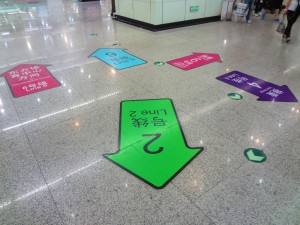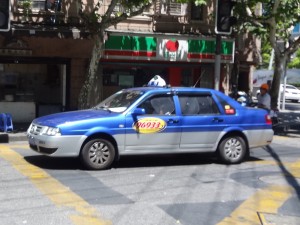Now that you know how to eat at a restaurant more properly, the next question is: how do I get there? You’re in luck–Shanghai has a number of ways of getting around town, all of which are reasonably priced. Shanghai is the New York of Asia, and has about twice the number of people, so you ought to expect large crowds and the absence of lines (queues for most of the rest of the world). The fewer people you want to be surrounded by, the more expensive it’s going to be. But by Western standards, almost all forms of transportation in China are moderately priced.
In my opinion, the best way to get around town is by taxi. You can sit up to four people in a taxi (you can try to convince the taxi driver to allow five, but they might kick you out or try to charge you more), but you don’t have to sit with anyone you don’t know. You can hail a taxi from just about anywhere, just approach a street and raise your hand in the air. Empty taxis are designated by a green light on top of the car. We were told at orientation that all taxis in Shanghai should be Volkswagons, but they come in a number of different colors. There are red, gold, green, and blue taxis, and the color implies the company the taxi is owned by. As a rule of thumb, avoid the red taxis because they have a negative reputation in Shanghai for poor drivers and getting passengers lost. Regardless of which color taxi you decide to pick, daytime cab fare starts at 14 RMB (Chinese Renminbi, also known as yuan, and popularly referred to as kuai). That’s a little over $2, so it’s not a bad deal for distances it’s too far to walk. The further you go, the more expensive it gets. Depending on how fast your taxi driver goes and how long the car is parked at red stop lights, the charge can go up considerably!
Sometimes it’s just too far to take a taxi. In that case, my recommendation is taking Shanghai’s new metro. Subway stations are relatively frequent and are well advertised by street signs. There are a dozen or so metro lines that criss-cross underneath the tall buildings of Shanghai. When you walk in the metro station, you will want to buy a ticket at one of the electronic kiosks. Select the English button to make things a little easier for yourself, and then touch the location you want to end up at. For example, one popular location is the People’s Square location, the Central Park of Shanghai. You click on People’s Square, and the kiosk will figure out the distance and associated cost with your subway journey there. For the most part, subway rides are about 4 RMB (about $0.75). If you plan on doing a lot of riding on the subway, it would be in your best interest to buy a refillable subway card that you can simply swipe at the security gate. You can purchase one of these at the Service Desk, and it will save you the hassle of buying a separate ticket each journey you make. Be careful–some people thought it would be a good idea to buy a large number of one-way tickets from the electronic kiosks. Unfortunately, those tickets are only good for one day from the time they were purchased, and therefore that money was wasted. Shanghai’s subway system is new and very well planned out and relatively clean–but it gets extremely crowded during rush hours (when the masses go to or come from work). Make sure you know where your wallet or purse is, and make sure to hold on to the handbars, so you don’t fall or lose any valuables.

Make the subway floor your best friend! Conveniently colored arrows direct you to the right subway line.
If you need to get out of town, then the train is for you. You need to buy your tickets early because seats fill up fast, but train tickets can be a cheap way to get around China. If you’re all the way in Shanghai, you’re probably going to want to make it to Beijing before long (you can’t leave China without seeing the Great Wall of China, obviously!). I’ll be straightforward with you: these tickets are a little more expensive. A one-way ticket from Shanghai to Beijing by bullet train (the world’s fastest, the one you’ve probably heard about on the news) takes about 4 hours and costs 555 RMB (close to $100). It might sound like a lot, but the less expensive tickets can take up to 14 hours, and some are for standing passengers only. So, if you want to make sure you won’t be on the train for an eternity, and if you don’t want to be standing the entire time, you might want to know what you’re getting into before you buy your ticket. The main train station in Shanghai has an English-speaking counter, so that’s where you’re going to want to go.
There are some modes of transportation I would not suggest in Shanghai, mainly public busses. Although these are the cheapest at only 2 RMB (about $0.33), they are extremely crowded and you as a Westerner might draw unwanted attention. If you’re going out of town, there are usually bus routes, but these can take large amounts of time. If you do decide to take the train, I warn you to get to the train station early! From someone who has run to more than one train in the train station, do not underestimate the time it takes to get to the train station, and remember that the train waits for absolutely no one! Train stations can be big and confusing, so try to get there as early as possible.
Now that you know all of that, the following are a couple vocabulary words that might help make your transportation experience go a little easier:
|
PIN YIN |
ENGLISH PRONUNCIATION |
MEANING |
|
Chuzuche |
Choo-zoo-cha |
Taxi |
|
Feiji |
Fay-gee |
Airplane |
|
Jichang |
Gee-chong |
Airport |
|
Ditie |
Dee-tee-ay |
Subway/Metro |
|
Ditie Zhan |
Dee-tee-ay Jon |
Subway Station |
|
Gongjiaoche |
Gong-gee-ow-cha |
Public Bus |
|
Shifu |
Sh-foo |
Mister/Driver |
|
Zuo Guai |
Zo Gwai |
Turn Left |
|
You Guai |
Yo Gwai |
Turn Right |
|
Ting |
Ting |
Stop |
|
Zenme Qu…? |
Zen-ma Chu…? |
How do I go to…? |
